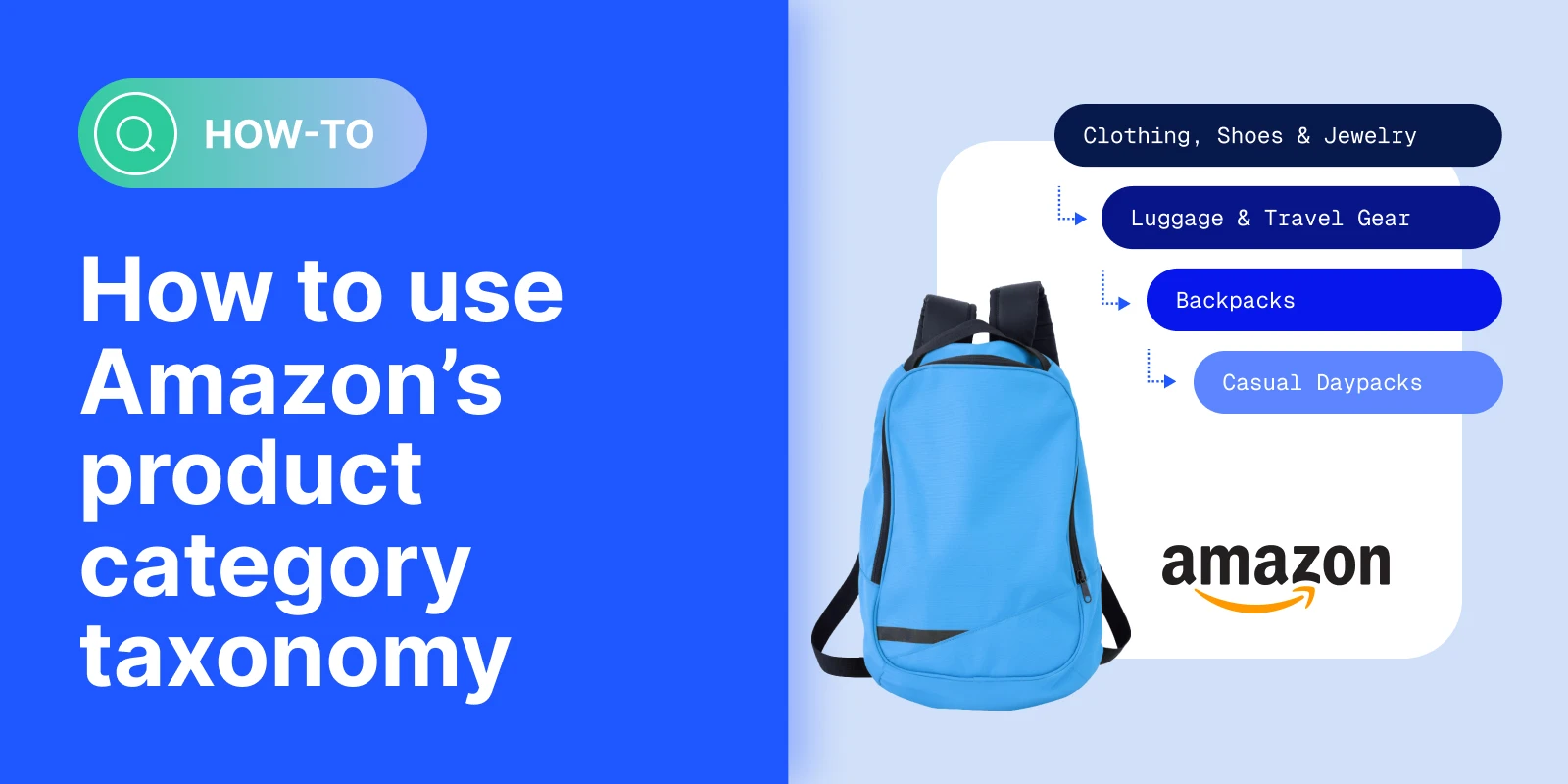Amazon organizes its marketplace listings using a structured system called a product category taxonomy, which helps shoppers find what they’re looking for and sellers show up in the right searches.
As of July 2025, Amazon’s taxonomy includes:
- Tens of thousands of browse nodes (categories and subcategories)
- Product type–driven templates that define required fields like size, gender, or material
- Localized taxonomy versions for different marketplaces (e.g., Amazon.com vs. Amazon.ca)
To properly categorize your products on Amazon, you should understand how these systems work:
Product type vs. browse nodes
Every product you list on Amazon must be assigned a product type and browse node (also known as category), which drives how it appears in search and filters.
Product Type
- What it is: A product type defines the core classification of an item. Think of it as a behind-the-scenes label that Amazon uses to determine which attributes, template fields, and listing rules apply to your product.
- Why it matters: Selecting the right product when creating a listing makes the process more convenient and accurate, because you’ll only be asked for data on product-specific attributes.
- Example: The “pillow” product type can refer to products such as bed pillows, throw pillows, and furniture pillows. Each product type has a corresponding template that allows you to provide relevant information about the product.
Browse Node (Category)
- What it is: A browse node is the customer-facing category or subcategory that determines where your product appears on the Amazon storefront. It’s part of Amazon’s hierarchical structure and is used to organize product listings into the appropriate categories.
- Why it matters: It affects product ranking, filters, and navigation within the Amazon store, helping customers find your item while browsing. Certain browse node IDs unlock additional attributes that are contextual to that category.
- Example: A product in Home & Kitchen > Bedding > Bed Pillows might have optional attributes like
pillow_shape,fill_material, orsleep_positionthat wouldn’t appear if you used a more general category like Home Décor > Throw Pillows.
Open vs. gated categories
Amazon splits its taxonomy into open categories, where most sellers can list freely, and gated categories, which require approval.
Open categories
These are accessible to all sellers with a Professional Selling Plan. Examples include:
- Home & Kitchen
- Sports & Outdoors
- Tools & Home Improvement
Gated categories
Approval is required to sell in these categories. Common gated categories include:
- Grocery & Gourmet Food
- Jewelry
- Fine Art
- Collectible Coins
Requirements may include:
- Performance metrics (e.g., order defect rate)
- Product documentation (e.g., invoices, safety testing)
- Participation in Amazon Brand Registry
For the latest list, visit Amazon Category Requirements.
How to use Amazon’s Browse Tree Guide
The Browse Tree Guide (BTG) is Amazon’s downloadable reference for mapping your products to the correct browse nodes. Each BTG contains:
- A list of valid category paths and node IDs
- Required and optional attributes by category
- Valid values for item_type_keywords
Sellers can use the BTG to:
- Identify where their product fits in Amazon’s taxonomy
- Find the correct node ID to submit via flat file or API
- Ensure compliance with category-specific rules
BTGs are marketplace-specific. Make sure you download the latest version for your regional Amazon site.
Using Amazon’s automated categorization (and its pitfalls)
Amazon’s systems have become more sophisticated, with machine learning increasingly used to auto-categorize products. While convenient, this automation isn’t always accurate, especially for products with ambiguous titles or limited attribute data.
Incorrect categorization can lead to:
- Suppressed listings
- Misleading filters
- Poor search visibility
- Violations of Amazon’s style guidelines
That’s why many sellers prefer to take control of taxonomy mapping with a feed management platform, especially when managing large catalogs or selling across multiple marketplaces.
Feedonomics: Smarter catalog management for Amazon
At Feedonomics, we make Amazon feed optimization seamless. Our platform and managed service teams help sellers:
- Map categories from Google Shopping, your ecommerce platform, or custom systems to Amazon taxonomy
- Match each SKU to the correct browse node and product type
- Fill in required category-specific fields automatically
- Prevent common listing errors and reduce suppressed ASINs
Even if you don’t have a product feed structured for Amazon, we can build one using your existing product data and ensure your listings are optimized and categories are mapped correctly.
Automate product listing and order management on Amazon
Amazon product category taxonomy FAQs
How does Amazon’s hierarchical structure affect product categorization and subcategories?
Amazon’s product taxonomy uses a hierarchical structure, where each product falls under a main category and increasingly specific subcategories. This structure helps match your product listings to the most relevant categories, improving visibility in search engines and on the Amazon marketplace. Accurate product categorization ensures your new product appears alongside similar products, enhancing the likelihood of ranking well and reaching your target audience.
Why is choosing the correct category and subcategories important for Amazon listings?
Selecting the right category and most specific subcategories ensures your Amazon listing is eligible for the appropriate product attributes, filters, and category-specific rules. Amazon Seller Central relies on these classifications to display the most relevant information to shoppers. Accurate product classification improves ranking, prevents listing suppression, and allows your product to show up in relevant search results on both Amazon and external search engines.
Can Feedonomics help Amazon sellers map their product catalog to appropriate categories?
Yes. Feedonomics helps Amazon sellers automate and optimize product categorization by mapping your product catalog to the correct category, including subcategories and product attributes. Whether you’re launching a new product or managing a large Amazon store, Feedonomics ensures your data complies with Amazon’s latest category list, improving performance and helping your products stand out among similar products.

Muhammed is a content marketing specialist creating informative content to help ecommerce professionals solve industry challenges and stay ahead of the curve.




